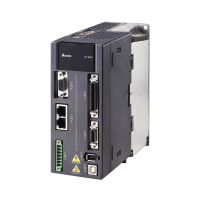AH500 Programming Manual
6-182
Ti_Ki
:
Integral gain (second or
1/seccond)
Double word
Td_Kd
:
Derivative gain (second) Double word
Tf
:
Derivative action time constant
(second)
Double word
PID_EQ
:
Selection of a PID formula Bit
PID_DE
:
Selection of the calculation of
the PID derivative error
Bit
PID_DIR
:
PID forward/reverse direction
(PID_DIR)
Bit
ERR_DBW
:
Range within which the error
value is count as 0
Double word
MV_MAX
:
Maximum output value
(MV_MAX)
Double word
MV_MIN
:
Minimum output value
(MV_MIN)
Double word
MOUT
:
Manual output value (MOUT) Double word
BIAS
:
Feedforward output value Double word
I_MV
:
Accumulated integral value
(I_MV)
Double word
MV
:
Output value (MV) Double word
Example:
1. The instruction is used to implement the advanced PID algorithm. When the instruction is
being executed by the PLC, the PID algorithm is implemented. PID stands for Proportional,
Integral, Derivative. The PID control is widely applied to mechanical equipment, pneumatic
equipment, and electronic equipment.
2. The setting of the parameters is as follows.
number
Function
Setting range Description Device number
PID_RUN
BOOL
Enabling the PID
algorithm
True: The PID algorithm is
implemented.
False: The output value (MV) is reset
to 0, and the PID algorithm is
SV
REAL
single-precision
floating-point
numbers
Target value
single-precision
floating-point
numbers
PV
REAL
single-precision
floating-point
numbers
Process value
single-precision
floating-point
numbers
PID_MODE
Double
word
/DINT
PID control mode
When PID_MAN is switched from
ON to OFF, the output value (MV)
then is involved in the automatic
algorithm.
1: The parameters are tuned
automatically for the temperature
control.
When the tuning of the parameters

